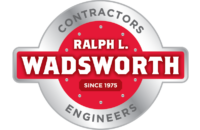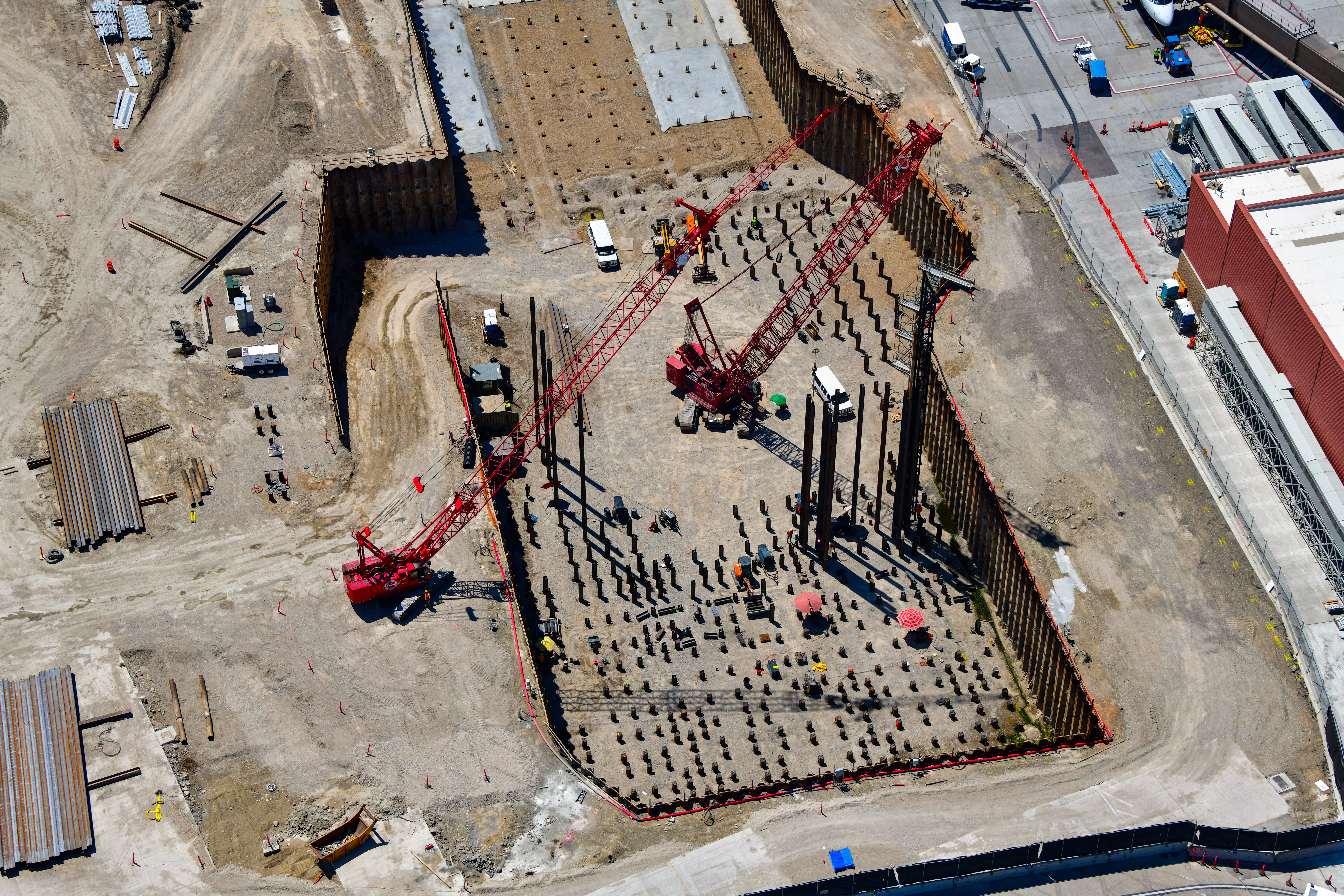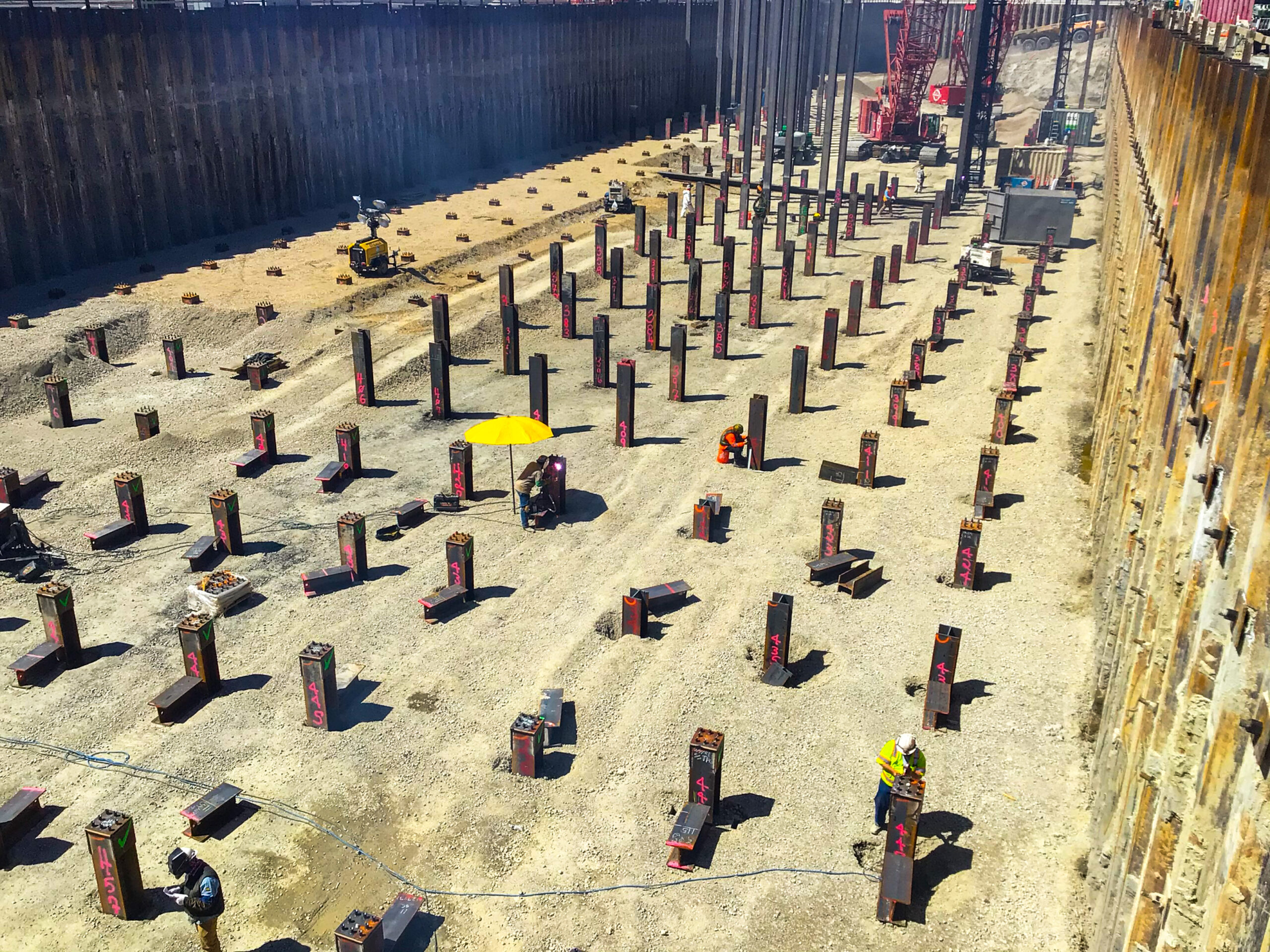Published on September 22nd, 2022 | by PILEDRIVER Magazine | Issue 4 2022 | Volume 20, No. 4
The second phase of the Salt Lake City Department of Airports (SLCDA) $3.6 billion redevelopment program will build the South Concourse East and the Central Tunnel to connect the South and North Concourses of the Salt Lake City International Airport. The tunnel is 935 feet long and approximately 115 feet wide and is constructed completely under the runway. It will be equipped with walkways, utilities, and a train (in future construction phases).
This program is the most recent effort to transform Salt Lake City International Airport into one of the nation’s most efficient airports. This complex construction program required more than 1,071 steel pipe piles and 1,517 steel H-piles to be manufactured, delivered and driven. The individual pipe pile lengths ranged from 60 ft. to 80 ft. per piece and H-piles to lengths up to 120 feet, which required the team to splice piles together.
Ralph L. Wadsworth Construction Company, LLC (RLW) worked as a subcontractor to HDJV Construction, a joint venture between Holder Construction and Big-D Construction. RLW overcame a multitude of challenges related to schedule, design, safety and logistics.
Logistics
In addition to planning for the manufacturing and delivery of this large quantity of piles, the length of the piles created challenges for transporting, storing and maneuvering them at the site. Manufactured in California and Mississippi by Skyline Steel, the piles were transported by barges and then by rail to Salt Lake City, Trucks with extra-long beds carried the 70-plus-foot long piles through city streets to the project site, transporting no more than six piles at a time. RLW carefully scheduled deliveries around traffic patterns and managed inventories to minimize the amount of storage space required onsite.
RLW’s team also procured and modified specialized pieces of equipment to unload trucks and move piles around the site. These machines used clamping forks to hold the large piles in place while moving, allowing the team to transport them efficiently and, more importantly, safely.
The massive size and scope of the entire construction program together with a single point of site access demanded extensive coordination with other contractors and trades working at the airport. RLW met with other contractors several times each week to plan deliveries, adjust storage areas, and coordinate sequencing details.
Equipment
In order to efficiently drive pile in these varied conditions, RLW utilized its full breadth of equipment – optimizing equipment strengths to specific challenges.
Cranes: Crews used 12000 Manitowoc cranes, 14000 Manitowoc cranes and 777 Manitowoc cranes, depending on the size of pile and the available crane staging areas at this active site.
Pile hammer leads: Both swinging leads and fixed leads were used to maximize production and safety.
Pile hammers: Crews used both the I-36 ICE Pile Hammer and the 1-46 ICE Pile Hammer according to the area’s soil conditions and proximity to buildings.
Skyline Steel was the steel supplier and maintained an aggressive manufacturing schedule.
Choosing driven piles
The use of driven piles allowed the piling crews to achieve an aggressive installation schedule, which was critical to starting and maintaining this project’s overall schedule to open the new facilities to the public.
The geotechnical characteristics of the site required some piles to be driven to depths of 120 feet in order to reach suitable soil. The driven pile types selected by the owner, design team and the contractor had a strong record of performance and durability in the same types of soils and geotechnical conditions.
In addition to being a reliable choice for the site’s geotechnical conditions, driven pile allowed crews to work in constrained areas, often alongside contractors from other trades.
Challenges and solutions
International steel shortages and manufacturing delays required the project team to carefully plan for its material needs. Knowing that the schedule was unforgiving and had no room for mistakes, RLW ordered steel at exact lengths. They purchased it early and stored it off-site, delivering it in an organized manner as needed. At the peak of production, RLW was bringing 80 piles per day to the site.
Further compounding this challenge was the constrained tunnel footprint. Construction of the Central Tunnel required crews to install driven pile inside a stretch of sheet pile tunnel. This confined area constrained the cranes rotation, swinging radius and ability to reach certain areas within the tunnel. This challenge required detailed hourly schedules to make sure that cranes had an accessible supply of steel piles that were ready for installation. To achieve this, RLW established a line assembly whereby steel piles were delivered, staged, prepared for installation, marked and organized by location, and delivered to the tunnel areas within reach of the cranes.
Because a portion of the tunnel contained a utility conflict, the original construction sequence required RLW to omit a portion of tunnel installation and return later to complete the installation after the utilities were relocated. RLW had to install a portion of the piles and then backfill them to create a step-up platform to allow the crane to track on top and drive the remaining. This allowed for more efficient construction in the constrained footprint of the tunnel.
Innovation
The site’s soil and geologic conditions fluctuate within different areas. The various structures required for the new concourse and the tunnel each had specific engineering requirements that called for different pile sizes and lengths. Construction of the tunnel occurred at various grades and depths. No two areas were exactly alike, which compelled a customized area-by-area approach to pile driving.
RLW developed a step-by-step work plan for each operation and ensured that piles were driven in a sequence that prevented any quality issues and maintained the overall schedule. These plans allowed crews to install piles for the tunnel with less than 2% deviation from the specifications. These plans allowed the team to operate six cranes for 10 or more hours each day while receiving 80 piles or more per day.
For the work performed immediately next to the existing airport terminal, vibration and noise impacts needed to be minimized to avoid disrupting airport operations. RLW used special equipment and techniques to mitigate pile driving effects, including predrilling sound curtains, optimized hammer selection and automated vibration monitoring with real-time text and email notifications if vibrations reached allowable limits.
Many piles were specified to be driven to depths of 120 feet, which required splicing that had to be UT tested. In order to maintain the aggressive schedule and execute high quality splicing operations, the team proposed a splice plate alternative that reduced the UT tests required and increased the splicing progress. By proposing this alternative, RLW was able to keep the hammer continuously working through daylight hours to maintain the schedule. This efficient approach allowed the team to continue installing 60 to 80 piles each day.
Cost savings
The steel fabrication schedule and industry-wide delays created an environment that could not tolerate mistakes in steel procurement or wasted materials. In order to avoid cost overruns, RLW ordered steel piles at the exact lengths necessary. To drive piles to depths of 120 feet, RLW spliced onsite. This allowed the team to reduce costs and schedule associated with having piles spliced prior to delivery,
Environmental considerations and requirements
The new South Concourse and Tunnel at Salt Lake City International Airport was designed to be constructed in phases on the existing footprint. This presented numerous challenges that required a high level of coordination between the construction team and airport operations. RLW used special equipment and techniques to reduce the disruption to the airport’s operations and public. These methods included the use of pile curtains to limit vibration impacts on existing structures, and vibration monitoring to ensure that vibration during pile driving was within safe and acceptable limits.
During construction, RLW’s management team adopted a proactive management approach for scheduling pricing and coordination. They coordinated with the owner’s construction and QA/ QC teams on quality requirements, hold points and materials testing and certification. They coordinated with the Federal Aviation Administration to ensure that all piling and foundation operations met federal guidelines – including those for crane heights. Using weekly schedule updates, the team pre-planned all operations, using weekends to complete key activities on time.
Award-worthy project
This project drove 2,588 piles in a short period of time, from March 2021 to August 2021. In order to achieve that schedule in a period of industry-wide steel shortages, RLW had to carefully plan each aspect of project delivery – from site access, to shipments, to staging and storage, and “just in time” deliveries to the site.
Not only was the pile driving team able to meet its schedule, they were also able to achieve the quality standard of less than 2% specification deviation at the tunnel and with an excellent safety record.
In summary, RLW met the challenge of this demanding project through an efficient driven pile operation, careful coordination with its supplier, Skyline Steel, and maintained RLW’s high quality standards.




